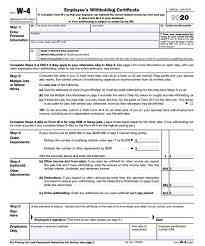We’re now 3 months into 2020. Are you still confused in terms of how to handle the 2020 W-4 form that completely revamps income tax withholding? If so, you’re not alone.
Help is on the way. Here’s what you need to know.
- Completing the 2020 W-4 isn’t for all of your employees. Only those receiving their first paycheck in 2020. If your current employees have no changes to their existing W-4s, they don’t need to fill out the new version. However, if they want to make changes, they’ll need to complete the new 2020 form. This means that you’ll have different W-4s on file. If you find this confusing, you can ask your employees hired before 2020 to complete and submit the new form. But, be sure they understand updating the form isn’t mandatory.
- There are no more withholding allowances. This is the biggest change to the 2020 W-4. As an employer, you may have relied on withholding allowances to calculate income tax withholdings. The more allowances your employees claimed, the less tax you withheld from their checks and vice versa. More than likely, your employees relied on these exemptions to get a sizeable refund check at tax time. However, with the new 2020 changes, employees can now claim dependents or other deductions.
- The 2020 W-4 looks different from past forms. When filling it out, employees must now:
– Enter personal information
– Indicate multiple jobs or if spouse works
– Claim dependents
– Make other adjustments (these are optional)
– Sign the form - With the previous form, an employee would enter personal information, claim allowances, and sign. They could also request an additional sum be withheld or claim exemption from their federal income tax withholding, if applicable. The new form enhances the accuracy of withholding by allowing your employees to factor in multiple jobs, or if they’re married and filing jointly, they can now factor in their spouses’ jobs. And in the instance they have children, they can factor them in and their non-children dependents. They must either claim dependents by multiplying the number of children by $2,000 and/or configure other dependents by multiplying by $500 per dependent. They can also factor in other income they may receive throughout the year. An example is if they receive interest, dividends, or retirement income. They can also use deductions they plan to use on their personal tax return only if they plan to itemize and not take the standard deduction. In addition, if your employees want to make an extra withholding, they can do that. To better prepare you for answering your new employees’ questions related to this change, visit the IRS’s website.
- Along with the newly-revised 2020 W-4, the IRS has issued new income tax withholding tables. Refer to the Percentage Method Tables for Automated Payroll Systems and the Wage Bracket Method Tables for Manual Payroll Systems that accompany the revised forms. If you manually handle payroll, refer to the wage bracket method tables. Each contains two rates for each filing status: “Standard withholding” and “Form W-4, Step 2, Checkbox withholding.” Note, though, that before you refer to the tables, you need to find the employee’s adjusted wage amount. Once located on the table, you must then account for any tax credits claimed and/or additional tax withholding requested on Form W-4.
- In the instance that your employees completed the pre-2020 W-4s, you’ll need to refer to the income tax withholding tables that support the 2019 and earlier versions of Form W-4, because these tables still include rates based on claimed withholding allowances.
- In addition to all of the above, you still need to address any state changes. That is, if your state has state income taxes, then your employees will need to complete a state W-4. And, depending on your state, it may or may not have its own W-4. If it doesn’t, simply use the federal W-4 form.
- To further complicate things, in 2020, the American Payroll Association says that states must decide whether they want to continue using the federal W-4 (and adjust their state tax system to comply with the lack of withholding allowances) or create their own version. For example, some states, such as Colorado, will continue using the federal W-4 form, while Nebraska chose to create its own W-4.
As with all changes, there’s a learning curve. If you’re still stressed or confused with these changes, consider using payroll software or a payroll service, such as ASAP Payroll, to help you navigate through the changes.







